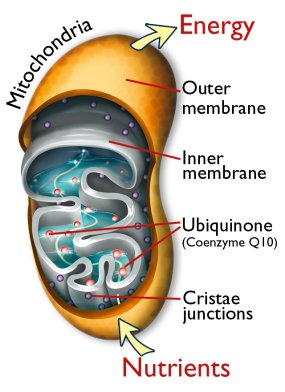How does Q10 affect athletic performance?
 Q10 is involved in the energy turnover in all cells. The highest concentration of the compound is found in the heart, as this muscle needs to pump day and night and to supply muscle cells with more blood when we are physically active. The cellular energy turnover takes place inside some minute powerhouses called mitochondria. A Danish-Swedish study has shown that the mitochondria in the muscle cells of top-notch athletes have a different construction that makes them able to produce up to 25 per cent more energy. Earlier studies show that Q10 is able to improve athletic performance, and it all boils down to optimizing the energy turnover in the cells.
Q10 is involved in the energy turnover in all cells. The highest concentration of the compound is found in the heart, as this muscle needs to pump day and night and to supply muscle cells with more blood when we are physically active. The cellular energy turnover takes place inside some minute powerhouses called mitochondria. A Danish-Swedish study has shown that the mitochondria in the muscle cells of top-notch athletes have a different construction that makes them able to produce up to 25 per cent more energy. Earlier studies show that Q10 is able to improve athletic performance, and it all boils down to optimizing the energy turnover in the cells.
The Scandinavian study revealed that the muscle cell mitochondria of football players and cross-country skiers are constructed in a way that enables them to produce 25 per cent more energy than the muscle cell mitochondria in people who are not sports-active. The energy turnover takes place in the inner membrane (cristae) of the mitochondria. The cristae resemble folded intestines. By studying cell samples from leg muscle tissue of elite athletes, the researchers found that the cristae had a larger surface. This means that the cells and their mitochondria are able to take up more oxygen and produce more energy.
The study has helped science understand how changes in the cristae can improve the mitochondrial energy turnover in step with the increased need for energy during prolonged periods of training. The researchers are still unable to say if the more effective mitochondria is an innate property, or if the training is what has changed their structure and energy potential. Science has known for decades that top-notch athletes typically have twice as many mitochondria in their muscle cells than people who are not sports-active. That, combined with the observation that the individual mitochondrion in muscle cells of athletes is able to produce more energy, contributes to increased performance and endurance.
The study got published in The Journal of Physiology in October 2016
|
The mitochondria are cellular powerhouses inside which Q10 converts nutrients into ATP, which is the primary energy currency of cells. |
Q10 throughout life
We humans produce our own Q10, but after we reach our 20s, our endogenous production begins to decrease as a natural part of the ageing process. Poor physical condition, chronic diseases, and the use of cholesterol-lowering statins are often associated with lower Q10 levels. Many older and diseased people and even athletes take daily supplements of Q10 as compensation.
Hard-working cells need more Q10 for several reasons
After we eat or drink, the mitochondria go to work and start converting carbohydrate and fatty acids into energy by means of Q10 and the oxygen that we breathe. First, Q10 contributes to storing the energy chemically in the form of a molecule called ATP (adenosine triphosphate). After that, Q10 releases Q10 in step with the energy demand of the cells.
The number of mitochondria in a cell (also called mitochondrial density) depends on the energy requirement of the cell. This explains why cells in the heart, skeletal muscle, brain, and liver have a large number of mitochondria and contain more Q10. With too little Q10 present, the mitochondria are no longer able to churn out enough energy to make the cells function optimally.
In addition, Q10 is a powerful antioxidant that protects cells against oxidative stress.
|
The aerobic combustion, which works most efficiently, takes place when we are not exerting ourselves physically. During the combustion of carbohydrate and fatty acids, cells use oxygen and Q10. The anaerobic combustion happens when we strain ourselves beyond the point where the blood is able to carry sufficient amounts of oxygen to the hardworking muscles. Only carbohydrate gets combusted, causing a buildup of lactic acid. Because of the lack of oxygen, we tend to get exhausted. |
Physical activities and fat burning
As mentioned earlier, muscle mitochondria are able to use both carbohydrate and fatty acids as an energy source. When we are not exerting ourselves, the source ratio is around fifty-fifty.
Mitochondria require more oxygen to burn fatty acids than to burn carbohydrate. In situations where our physical activity reaches the point where we get exhausted because of the relative lack of oxygen, the mitochondria shift to burning carbohydrate, which they burn faster and with less oxygen or none at all.
The more fit we are, and the longer it takes for us to become exhausted, the more effectively the muscle mitochondria are able to burn fatty acids, which is a solid and concentrated energy source. At the same time, as described above, the number of mitochondria in the muscle tissue of elite athletes can easily be twice that of normal.
Muscle fibers, fat burning, and Q10The more fit you are, the more easily your muscles burn fatty acids. The muscle fibers that rely on fatty acids as their primary energy source also have greater energy uptake and contain particularly many mitochondria. |
Cells gather Q10 from the bloodstream for intensive energy turnover
Heart and muscle cells contain quite a lot of Q10 in the first place, which suggests that the cells get a large amount of Q10 from the bloodstream when they need it for intensive energy turnover and protection against free radicals. Apparently, sports-active people have less Q10 in their blood than those who are not. Q10 levels in the blood are lowest when a person is training intensively.
| In competitive sport, fine margins often determine who wins medals, and several studies have shown that supplementing with Q10 can really make a difference. |
Greater oxygen uptake and shorter restitution
As part of a German placebo-controlled study, a group of elite athletes preparing for the Olympic Games in London in 2012 received a daily 300 mg supplement of Q10 for six weeks. This resulted in significant improvements of their performance. Researchers from Olympiastützpunkt Rhein in Essen, Germany, conducted the study. Finnish researchers have made a similar study of top-notch cross-country skiers where they found that supplementing with 90 mg of Q10 daily significantly improved the skiers’ physical performance. The scientists observed that the skiers’ oxygen uptake had improved and they were able to perform better because their lactic acid threshold had also improved.
The majority of skiers in the study even reported that supplementing with Q10 had reduced the time they took to restitute. Although these were subjective observations, it is a highly relevant issue in sport. Both the German and the Finnish study revealed that supplementing with Q10 can improve both performance and the lactic acid threshold that is reached when combustion becomes anaerobic (without oxygen).
The heart is in particular need of Q10 and fatty acids
Because the heart is such a hard-working muscle, it contains more mitochondria and Q10 than any other part of the human body. In fact, mitochondria represent a third of the heart’s dry weight. The large concentration of mitochondria and Q10 is also explained by the fact that the heart’s primary energy source is fatty acids, and it takes quite a lot of oxygen to convert them into energy. Therefore, do not avoid fat in your diet. On the contrary. The only thing to be aware of is to choose the healthy fats as an energy source.
Why does the Q10 content in the heart decrease, as we grow older?
The concentration of Q10 in the heart tends to drop when we grow older because of the reduced endogenous production of the substance. To begin with, it may be difficult to define typical changes in body function, as they may turn up as insidious signs such as fatigue, impaired performance, and other diffuse symptoms. |
Cholesterol-lowering medicine lowers the body’s endogenous Q10 production
Cholesterol-lowering drugs (statins) are associated with numerous adverse effects that tend to have a greater impact on athletes. This is because cholesterol and Q10 are related and both get synthesized from the HMG-CoA enzyme. Because statins work by blocking the production of HMG-CoA, they also block the production of Q10. This provides a biochemical explanation to the statin-induced side effects that include muscle pain, fatigue, and shortness of breath because the cells lack energy.
A Danish study that is published in Journal of the American College of Cardiology reveals that 40 per cent of patients on statins have muscle pain. With athletes, the number is 75 percent, which means that the risk of side effects increases with physical activity.
Choose a Q10 supplement that the body is able to absorb and utilize
Q10 is a lipid-soluble molecule and the Q10 molecules in supplements are always lipid-soluble. With Q10 in various types of raw material and supplements, the Q10 molecules appear as a crystalline material. The problem is that we humans are unable to dissolve these crystals at normal body temperature. However, by employing a special oil and heating technique it is possible for the crystals to dissolve completely into free Q10 molecules that can easily pass through the intestinal wall and enter the bloodstream. It pays off to choose a Q10 supplement that can document its good quality, absorption and bioavailability to ensure that the active compounds effectively reaches the mitochondria of the cells.
References:
Joachim Nielsen et al. Plasticity in mitochondrial cristae density allows metabolic capacity modulation in human skeletal muscle.
The Journal of Physiology, 2016
http://onlinelibrary.wiley.com/doi/10.1113/JP273040/full
Deichmann RE et al: Impact of coenzyme Q-10 on parameters of cardiorespiratory fitness and muscle performance in older athletes taking statins. Phys Sportsmed. 2012
Echtay K.S. et al. Q10 activates Uncoupling proteins. Proc Natl Sci USA
Knut T Flytlie og Bjørn Madsen: Q10 Body Fuel. Ny Videnskab 2009
Pernille Lund: Q10 – fra helsekost til epokegørende medicin
http://www.ncbi.nlm.nih.gov/pmc/articles/PMC2846622/
Search for more information...
- Created on .











 "After about one week of taking the Q10 supplement I could feel a huge difference," says 23-year old Alan Piccini, who has been suffering from extreme fatigue and muscle aches ever since he was a child.
"After about one week of taking the Q10 supplement I could feel a huge difference," says 23-year old Alan Piccini, who has been suffering from extreme fatigue and muscle aches ever since he was a child. “Taking capsules with co-enzyme Q10 has freed me of the severe side effects of my cholesterol lowering medicine,” Mrs Franken explains.
“Taking capsules with co-enzyme Q10 has freed me of the severe side effects of my cholesterol lowering medicine,” Mrs Franken explains.